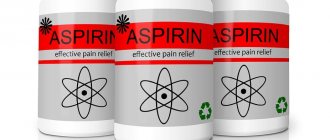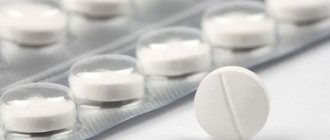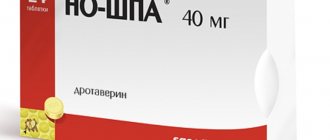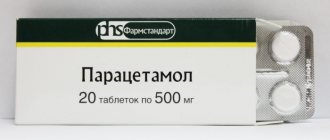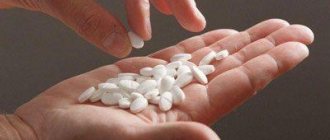Category: Drug poisoning
Concor is a selective β1-adrenergic receptor blocker used for certain cardiac diseases. It should be used on the recommendation of a specialist, observing the dosage and frequency of administration. An overdose of Concor poses a serious danger, so it is important to promptly provide assistance to the victim and contact a medical facility.
The pharmacological agent is produced in the form of Concor 5 mg and 10 mg tablets, sold in the pharmacy chain without a prescription.
The active substance of the drug is bisoprolol. This is a selective β1-blocker that does not have sympathomimetic activity or membrane-stabilizing effect.
Bisoprolol has virtually no effect on metabolic processes involving adrenergic receptors and airway resistance. Even in large dosages, the drug has a selective effect on β1-adrenergic receptors. Does not significantly reduce the strength of the CC.
Mechanism of action of Concor
The drug reduces the need for oxygen in the heart muscle and reduces heart rate under different conditions. Average doses of the drug do not affect the frequency and strength of heart contraction. The drug exhibits membrane-stabilizing properties.
Action of the medicine:
- stabilizes heart rhythm;
- hypotensive effect;
- reducing the oxygen demand of the heart muscle, preventing ischemia.
With a further increase in the therapeutic dosage, the drug exhibits a β2-adrenergic blocking effect, which, unlike selective drugs, has less effect on organs that have β2-adrenergic receptors, and has virtually no effect on carbohydrate metabolism.
Interaction
The drug reduces the need for oxygen in the heart muscle and reduces heart rate under different conditions. Average doses of the drug do not affect the frequency and strength of heart contraction. The drug exhibits membrane-stabilizing properties.
- stabilizes heart rhythm;
- hypotensive effect;
- reducing the oxygen demand of the heart muscle, preventing ischemia.
With a further increase in the therapeutic dosage, the drug exhibits a β2-adrenergic blocking effect, which, unlike selective drugs, has less effect on organs that have β2-adrenergic receptors, and has virtually no effect on carbohydrate metabolism.
https://www.youtube.com/watch?v=venN9sar-Ys
The frequency of adverse reactions listed below was determined according to the following criteria recommended by WHO: very often (≥1/10); often (≥1/100, {amp}lt;1/10); uncommon (≥1/1000, {amp}lt;1/100); rare (≥1/10000, {amp}lt;1/1000); very rare ({amp}lt;1/10000).
From the nervous system: often - dizziness1, headache1; rarely - loss of consciousness.
From the mental side: infrequently - depression, insomnia; rarely - hallucinations, nightmares.
On the part of the organ of vision: rarely - decreased tear production (should be taken into account when wearing contact lenses); very rarely - conjunctivitis.
From the organ of hearing and labyrinthine disorders: rarely - hearing impairment.
From the cardiovascular system: very often - bradycardia (in patients with CHF); often - worsening symptoms of CHF (in patients with CHF), a feeling of coldness or numbness in the extremities, a marked decrease in blood pressure, especially in patients with CHF; uncommon - AV conduction disturbance, bradycardia (in patients with arterial hypertension or angina pectoris), worsening of symptoms of CHF (in patients with arterial hypertension or angina pectoris), orthostatic hypotension.
From the respiratory system, chest and mediastinal organs: infrequently - bronchospasm in patients with bronchial asthma or a history of airway obstruction; rarely - allergic rhinitis.
From the gastrointestinal tract: often - nausea, vomiting, diarrhea, constipation.
From the liver and biliary tract: rarely - hepatitis.
From the musculoskeletal and connective tissue side: infrequently - muscle weakness, muscle cramps.
From the skin and subcutaneous tissues: rarely - hypersensitivity reactions, such as itching, skin rash, hyperemia of the skin; very rarely - alopecia.
β-blockers can contribute to the exacerbation of psoriasis symptoms or cause a psoriasis-like rash.
From the genital organs and mammary gland: rarely - impaired potency.
General disorders and disorders at the injection site: often - asthenia (in patients with CHF), increased fatigue1; infrequently - asthenia (in patients with arterial hypertension or angina pectoris).
Laboratory and instrumental data: rarely - increased concentration of triglycerides and activity of AST and ALT in the blood plasma.
1 In patients with arterial hypertension or angina, these symptoms especially often appear at the beginning of treatment. Typically, these phenomena are mild in nature and usually disappear within 1–2 weeks after the start of treatment.
The effectiveness and tolerability of bisoprolol may be affected by the simultaneous use of other drugs. Such interaction can also occur in cases where two drugs are taken after a short period of time.
Combinations not recommended
Treatment of CHF. Class I antiarrhythmic drugs (for example, quinidine, disopyramide, lidocaine, phenytoin, flecainide, propafenone), when used simultaneously with bisoprolol, can reduce AV conduction and myocardial contractility.
All indications for the use of bisoprolol. CCBs such as verapamil and, to a lesser extent, diltiazem, when used simultaneously with bisoprolol, can lead to a decrease in myocardial contractility and impaired AV conduction. In particular, intravenous administration of verapamil to patients taking beta-blockers can lead to severe arterial hypotension and AV block.
Centrally acting antihypertensive drugs (such as clonidine, methyldopa, moxonidine, rilmenidine) can lead to a decrease in heart rate and a decrease in cardiac output, as well as vasodilation due to a decrease in central sympathetic tone. Abrupt withdrawal, especially before discontinuation of beta-blockers, may increase the risk of rebound hypertension.
Combinations requiring special caution
Treatment of arterial hypertension and angina pectoris. Class I antiarrhythmic drugs (for example, quinidine, disopyramide, lidocaine, phenytoin, flecainide, propafenone), when used simultaneously with bisoprolol, can reduce AV conduction and myocardial contractility.
All indications for the use of bisoprolol. CCBs - dihydropyridine derivatives (for example, nifedipine, felodipine, amlodipine) - when used simultaneously with bisoprolol, may increase the risk of developing arterial hypotension. In patients with CHF, the risk of subsequent deterioration in cardiac contractility cannot be excluded.
Class III antiarrhythmic drugs (eg amiodarone) may worsen AV conduction disturbances.
The effect of topical β-blockers (for example, eye drops for the treatment of glaucoma) may enhance the systemic effects of bisoprolol (lowering blood pressure, lowering heart rate).
Parasympathomimetics, when used simultaneously with bisoprolol, may enhance AV conduction disturbances and increase the risk of developing bradycardia.
The hypoglycemic effect of insulin or hypoglycemic drugs for oral administration may be enhanced. Signs of hypoglycemia, in particular tachycardia, may be masked or suppressed. Such an interaction is more likely when using non-selective beta-blockers.
Drugs for general anesthesia may increase the risk of cardiodepressive effects, leading to arterial hypotension (see “Precautions”).
Cardiac glycosides, when used simultaneously with bisoprolol, can lead to an increase in impulse conduction time and thus to the development of bradycardia. NSAIDs may reduce the antihypertensive effect of bisoprolol.
The simultaneous use of bisoprolol with β-adrenergic agonists (for example, isoprenaline, dobutamine) may lead to a decrease in the effect of both drugs. The use of bisoprolol with adrenergic agonists that affect α- and β-adrenergic receptors (for example, norepinephrine, epinephrine) may enhance the vasoconstrictor effects of these drugs that occur with the participation of α-adrenergic receptors, leading to an increase in blood pressure. Such interactions are more likely when using non-selective beta-blockers.
Antihypertensive drugs, as well as other drugs with a possible antihypertensive effect (for example, tricyclic antidepressants, barbiturates, phenothiazines), can enhance the antihypertensive effect of bisoprolol.
Mefloquine, when used simultaneously with bisoprolol, may increase the risk of bradycardia.
MAO inhibitors (except MAO B inhibitors) may enhance the antihypertensive effect of β-blockers. Concomitant use may also lead to the development of a hypertensive crisis.
Indications for use
The main indications for treatment with the drug are heart disease and high blood pressure. Since the drug is considered a potent drug, it is dangerous to use it without the advice of a specialist. Dosage varies depending on the specific disease and overall health.
Indications:
- IHD (stable angina);
- hypertension;
- chronic heart failure.
In each specific case, Concor has its own dosage and frequency of administration. Most often used as part of complex treatment.
Composition, release form
Bisoprolol is available in tablets. They are round in shape and beige in color. The main active ingredient is bisoprolol fumarate. It can be contained in a tablet in a volume of 2.5, 5, 10 mg.
Bisoprolol tablets
The excipients here are: colloidal silicon dioxide, pregelatinized starch, povidone, magnesium stearate, croscarmellose sodium, lactose, microcrystalline cellulose, talc. The drug shell consists of iron oxide dye, talc, titanium dioxide, polyvinyl alcohol, macrogol.
These tablets are packaged in special cells, one plate of which contains 10 pieces. Next, they are placed in cardboard boxes of 3 plates. They can also be placed in 30 pieces in dark jars or polymer vessels.
Combination of Concor with other medications
When prescribing the drug, the doctor takes into account the compatibility of medications of different groups with Concor.
Adjusts medication doses depending on the components of complex therapy. Concor is not compatible:
- with antihypertensive drugs (Clonidine, Reserpine, Guanfacine), since withdrawal of one of them can cause a response arterial surge and cardiac conduction disturbances;
- with sodium channel blockers (Novocainamide, Quinidine, Lidocaine);
- with calcium blockers (Verapamil, Diltiazem, Nifedipine), a sharp decrease in blood pressure is possible, the risk of AV block, cardiac arrest;
In addition, Concor is absolutely incompatible with antidepressants (Metralindole, Pheninzil). Under its influence, the effect of hypoglycemic drugs may change and the effect of muscle relaxants may be prolonged.
Notes[ | ]
- Bühring KU, Sailer H., Faro HP, Leopold G., Pabst J., Garbe A.
Pharmacokinetics and metabolism of bisoprolol-14C in three animal species and in humans (English) // J. Cardiovasc. Pharmacol. : journal. - 1986. - Vol. 8 Suppl 11. - P. S21-8. - PMID 2439794. - Leopold G.
Balanced pharmacokinetics and metabolism of bisoprolol (English) // J. Cardiovasc. Pharmacol. : journal. - 1986. - Vol. 8 Suppl 11. - P. S16-20. - PMID 2439789. - Bisoprolol (BIS-oh-PROE-lol). //Drugs.com
- WHO Model List of EssentialMedicines (undefined)
.
World Health Organization
(October 2013). Retrieved July 6, 2014. - Drug interactions. Bisoprolol Archived November 3, 2014 on the Wayback Machine
- Bisoprolol. Register of Medicines of Russia.
Contraindications of the drug
Concor is not used for pathologies of the liver, circulatory system and lungs, during pregnancy and lactation, as well as in case of individual intolerance. Taking the drug by persons under 18 years of age is strictly prohibited.
Absolute contraindications:
- AV block II–III degree;
- bradycardia;
- Raynaud's disease;
- severe peripheral circulatory disorder;
- severe hypotension;
- severe forms of asthma;
- metabolic acidosis;
- taking MAO inhibitors.
Relative contraindications:
- Prinzmetal's angina;
- allergy treatment period;
- hyperthyroidism;
- AV blockade, stage I ;
- psoriasis;
- hereditary heart defects.
The drug significantly reduces the volume of blood ejection, so it is completely contraindicated in cases of hypotension, cardiogenic shock and collapse. Concor is used with caution for diabetes, asthma, lung and liver pathologies.
Bisoprolol-ratiopharm
Selective β1-adrenergic receptor blocker without BCA. Blocks β1-adrenergic receptors and reduces the effect of catecholamines on them. It has a hypotensive and antianginal effect. The hypotensive effect is due to a decrease in IOC, a decrease in sympathetic stimulation of peripheral vessels and inhibition of renin release by the kidneys.
The antianginal effect is due to the blockade of β1-adrenergic receptors, which leads to a decrease in heart function due to negative chronotropic and inotropic effects. Thus, bisoprolol (INN - bisoprololum) eliminates or reduces the severity of symptoms of myocardial ischemia. Bisoprolol is almost completely (up to 90%) absorbed from the gastrointestinal tract.
The effect of primary passage through the liver is very slight, due to which the drug has high bioavailability - about 90%. The half-life is 10–12 hours, which provides a therapeutic effect for 24 hours when taken once a day. More than 95% of the active substance is excreted by the kidneys, 50% unchanged.
Active metabolites are not formed in the human body.
Indications for use of the drug Bisoprolol-ratiopharm
Arterial hypertension (AH), ischemic heart disease (stable angina).
Use of the drug Bisoprolol-ratiopharm
Orally, therapeutic dose - 5-10 mg 1 time per day, maximum daily dose - 20 mg.
In patients with impaired renal or liver function (creatinine clearance less than 20 ml/min), the dose of Bisoprolol-ratiopharm should not exceed 10 mg 1 time per day (this dose can be divided into two).
In elderly patients, no dose adjustment is required. It is recommended to start using the drug with the lowest possible dose.
When discontinuing the drug, the dose is reduced gradually (by half the dose daily).
Contraindications to the use of the drug Bisoprolol-ratiopharm
Hypersensitivity to bisoprolol or other components of the drug, chronic heart failure in the decompensation phase, cardiogenic shock, AV block II-III degree, sick sinus syndrome, sinoatrial block II degree, bradycardia (heart rate ≤50 beats.
/min), tendency to bronchospasms (BA, obstructive airway diseases), arterial hypotension (systolic blood pressure ≤90 mm Hg), late stages of peripheral circulatory disorders, simultaneous use of MAO inhibitors (except MAO-B), age up to 12 years old.
Side effects of the drug Bisoprolol-ratiopharm
From the cardiovascular system: bradycardia, arterial hypotension (including orthostatic hypotension), rarely - slowing of AV conduction or strengthening of existing AV blockade, arrhythmias, appearance/intensification of manifestations of heart failure with worsening peripheral circulation, the course of Raynaud's disease, with worsening of existing intermittent claudication. From the side of the central nervous system: increased fatigue, unmotivated weakness, dizziness, headache, rarely - anxiety, irritability, sleep disturbance, depression, confusion (especially in elderly patients), vivid dreams, depressed state. From the gastrointestinal tract: nausea, vomiting, diarrhea, abdominal pain, constipation, increased levels of liver enzymes (AST, ALT), hepatitis. From the respiratory system: rhinitis, shortness of breath, bronchospasm (especially in patients with asthma or a history of obstructive bronchial diseases); Skin reactions: rash. From the hearing organs: hearing loss. From the organs of vision: dry eyes, eye pain, conjunctivitis. Metabolic disorders: increased TG levels, hypoglycemia. In patients with a latent form of diabetes mellitus or manifestations of this disease, it is possible to reduce glucose tolerance and mask the manifestations of hypoglycemia. There have been reports of increased symptoms of psoriasis or the development of a psoriasis-like rash.
In isolated cases, during treatment with beta-adrenergic receptor blockers, the following were observed: alopecia, tinnitus, weight gain, emotional lability, temporary memory loss, allergic rhinitis, hypersensitivity reactions, autoimmune disorders such as systemic lupus, decreased sexual function, dysuria, taste disturbance , nonspecific disorders - muscle weakness, cramps, pain in muscles and joints.
Special instructions for the use of the drug Bisoprolol-ratiopharm
Use with caution in patients with first degree AV block, cardiac and peripheral circulatory disorders, including Raynaud's disease and metabolic acidosis. β-adrenergic blockers may provoke or increase the frequency and duration of attacks of vasospastic angina/Prinzmetal angina.
It is not recommended to prescribe the drug to patients with COPD or, if necessary, use it in lower doses (initial dose - 2.5 mg / day) in combination with bronchodilators. The drug should be used with caution in patients with diabetes mellitus with significant fluctuations in glycemic levels and metabolic acidosis.
For the treatment of patients with severe pheochromocytoma, the drug is used only in combination with β-adrenergic receptor blockers. Bisoprolol-ratiopharm may mask the symptoms of thyrotoxicosis or hypoglycemia. At heart rate ≤50–55 beats/min per 1 min, the dose of the drug should be reduced.
In congestive heart failure, it is necessary to evaluate the benefit/risk ratio due to possible inhibition of myocardial contractility. Treatment begins with a minimum dose of 2.5 mg. Bisoprolol-ratiopharm should be used with caution in patients with psoriasis, including a history of psoriasis.
The drug may increase sensitivity to allergens and the severity of allergic reactions. In patients with coronary artery disease, sudden withdrawal of the drug may develop withdrawal syndrome. Therefore, drug withdrawal and dose reduction should be done gradually.
Each tablet contains approximately 130 mg of lactose, each recommended dose contains 130–260 mg of lactose, which should be advised in patients with galactosemia or glucose/galactose malabsorption syndrome. The drug gives a positive result during doping control.
During pregnancy, the use of the drug is possible only after a thorough assessment of the benefit/risk ratio for the mother and fetus. Given the lack of information regarding the content of the drug in breast milk, its use during breastfeeding is not recommended. The drug should not be prescribed to children under 12 years of age due to lack of experience in use.
The drug does not affect the ability to drive vehicles or operate other machinery, but due to possible individual reactions, caution should be exercised when using the drug (especially at the beginning of treatment).
Interactions of the drug Bisoprolol-ratiopharm
Combinations (due to the possibility of decreased activity) with floctafenine, sultopride, and MAO inhibitors (except MAO-B) are contraindicated. Allergens used for immunotherapy, allergen extracts for skin testing in combination with β-adrenergic receptor blockers can provoke the development of severe systemic allergic reactions.
Combinations of bisoprolol with calcium antagonists (verapamil, diltiazem, bepridil) are not recommended/require special caution due to an increased negative effect on myocardial inotropic function, AV conductivity, and blood pressure. Drugs containing clonidine, reserpine, alpha-methyldopa should not be prescribed simultaneously with bisoprolol due to a possible slowdown in heart rate.
Clonidine, digitalis, guanfacine can inhibit AV conduction. If combination therapy of bisoprolol with clonidine is discontinued, then after stopping clonidine, treatment with bisoprolol should be continued for several more days, ensuring medical monitoring of the patient's condition.
Combinations requiring caution: class I antiarrhythmic drugs (eg disopyramide, quinidine, lidocaine, diphenine, propafenone); class III antiarrhythmic drugs (amiodarone, sotalol); calcium antagonists (dihydropyridine derivatives) - due to an increased risk of arterial hypotension and heart failure.
The effect of insulin and oral hypoglycemic drugs may be enhanced when used simultaneously with bisoprolol. Cardiac glycosides: decrease in heart rate, prolongation of AV conduction. Baclofen: increased antihypertensive activity. Contrast agents containing iodine: β-adrenergic blockers may increase the risk of anaphylactic reactions.
Drugs that block prostaglandin synthesis (in particular NSAIDs): decreased antihypertensive effect. Ergotamine derivatives: exacerbation of peripheral circulatory disorders. Sympathomimetic agents: combination with bisoprolol may reduce the effects of both drugs.
Tricyclic antidepressants, barbiturates, phenothiazines, other antihypertensive drugs: enhance the effect of lowering blood pressure. Antihypertensive drugs (diuretics, ACE inhibitors, β-adrenergic receptor blockers) and nitrates potentiate the antihypertensive effect of bisoprolol. Corticosteroids: the antihypertensive effect may be reduced due to water and sodium retention.
Inhalation anesthetics and hydrocarbon derivatives (chloroform, cyclopropane, halothane, methoxyfuran, etc.) when used simultaneously with β-adrenergic receptor blockers increase the risk of inhibition of myocardial function and the development of hypotensive reactions.
The effect of depolarizing blockers of neuromuscular transmission can be enhanced and prolonged by the influence of beta-adrenergic receptor blockers. Cimetidine may reduce the clearance of β-adrenergic blockers that are metabolized in the liver and accordingly increase their bioavailability. The simultaneous use of rifampicin slightly accelerates the metabolism of bisoprolol, but in this situation there is no need to adjust the dose of the drug.
Xanthines (aminophylline, theophylline) may mutually reduce the therapeutic effects when combined with beta-adrenergic receptor blockers.
Overdose of the drug Bisoprolol-ratiopharm
Manifested by bradycardia, arterial hypotension, heart failure, arrhythmia, bronchospasm, respiratory failure, acrocyanosis, convulsions.
Treatment: discontinuation of the drug, gastric lavage, use of enterosorbents (activated carbon), laxatives (sodium sulfate).
If overdose symptoms do not disappear, hospitalization and treatment in a hospital are necessary.
Side effects in case of overdose
At the beginning of treatment with the drug, weakness, sleep disturbances, dizziness and migraine, depression, and sometimes hallucinations or paresthesia are possible.
Dryness and inflammation of the mucous membranes of the eyeballs and visual impairment are also observed. Other side effects:
- Sometimes bradycardia, hypotension, and exacerbation occur in patients with Raynaud's syndrome and intermittent claudication. In rare cases, patients with respiratory disorders experience shortness of breath.
- From the gastrointestinal tract - nausea, constipation or diarrhea, jaundice. From the musculoskeletal system - arthritis, cramps, muscle weakness.
- The skin may experience rashes, itching, and redness. Often the patient's sweating increases and the scalp and body become bald.
- Men may have problems with potency, as well as prolonged erection (priapism), which is not preceded by sexual arousal. Priapism is accompanied by pain and does not go away even after ejaculation; if blood flow is disrupted, it can cause gangrene.
- Other unpleasant consequences include: severe mood swings, congestion and tinnitus (often accompanied by hearing impairment), excess weight gain, and a runny nose of an allergic nature.
Often, side effects disappear spontaneously with further treatment or when the dosage is reduced. In persistent cases, you should consult a doctor to change the drug.
Reviews
Mostly positive reviews are left about the drug Bisoprolol.
Patients report its high and rapid effectiveness; another advantage is that the medicine should be taken once a day and at any time, which is very convenient.
In terms of price, reviews are mixed; for some it is acceptable, while others consider it expensive.
The disadvantages also indicate the presence of possible side effects, of which there are a lot. However, there are practically no comments about their manifestations.
Causes and symptoms of drug overdose
Poisoning with Concor most often occurs during self-medication, when the patient takes the drug on the recommendation of loved ones. An overdose is also possible as a result of an unforeseen situation when the patient feels a sharp deterioration in his condition (for example, during a hypertensive crisis) and in a panic takes the first available blood pressure medications.
An overdose of Concor in children can occur if the medications are stored carelessly. Intoxication at an early age occurs with pronounced symptoms and can have more serious consequences.
You will like the article: “ Lethally life-threatening drugs and pills - list .”
The first symptoms of Concor poisoning appear 15 minutes after administration. The victim's condition deteriorates sharply. The severity of intoxication depends on how much of the drug was taken.
The lethal dose of the drug varies from person to person. The highest daily dosage in adults is 20 mg; exceeding it in the presence of cardiac pathologies can be fatal.
Symptoms of intoxication:
- weakness;
- increased fatigue;
- pale skin, cold sweat;
- decrease in pressure;
- heart failure;
- bradycardia;
- severe pain and noise in the head;
- shortness of breath, bronchospasm;
- loss of consciousness.
A drop in pressure below the permissible level can lead to tragic consequences. If symptoms of poisoning occur, the specialist prescribes gastric lavage, diuretics, sorbents, and glucose-containing agents.
Pharmacology
Pharmacodynamics
A selective β1-blocker, without its own sympathomimetic activity, does not have a membrane-stabilizing effect. It has only slight affinity for β2-adrenergic receptors of the smooth muscles of the bronchi and blood vessels, as well as for β2-adrenergic receptors involved in the regulation of metabolism. Therefore, bisoprolol generally does not affect airway resistance and metabolic processes in which β2-adrenergic receptors are involved.
The selective effect of bisoprolol on β1-adrenergic receptors persists beyond the therapeutic range.
Bisoprolol does not have a pronounced negative inotropic effect. Its maximum effect is achieved 3–4 hours after oral administration. Even when bisoprolol is used once a day, its therapeutic effect persists for 24 hours due to the 10-12 hour T1/2 from blood plasma. As a rule, the maximum reduction in blood pressure is achieved 2 weeks after the start of treatment.
Bisoprolol reduces the activity of the sympathoadrenal system by blocking β1-adrenergic receptors of the heart.
When administered once orally in patients with coronary artery disease without signs of CHF, bisoprolol reduces heart rate, reduces the stroke volume of the heart and, as a result, reduces the ejection fraction and myocardial oxygen demand. With long-term therapy, the initially elevated TPR decreases. A decrease in renin activity in blood plasma is considered as one of the components of the antihypertensive effect of β-blockers.
Pharmacokinetics
Suction
Bisoprolol is almost completely (90%) absorbed from the gastrointestinal tract. Its bioavailability due to minor metabolization during the initial passage through the liver (>10%) is about 90% after oral administration. Food intake does not affect bioavailability. Bisoprolol exhibits linear kinetics, with its plasma concentration being proportional to the dose taken in the range from 5 to 20 mg. Tmax in blood plasma is 2–3 hours.
Distribution
Bisoprolol is distributed quite widely. Vd is 3.5 l/kg. The binding to plasma proteins reaches approximately 30%.
Metabolism
Metabolized via the oxidative pathway without subsequent conjugation. All metabolites are polar (water-soluble) and are excreted by the kidneys. The main metabolites found in blood plasma and urine do not exhibit pharmacological activity. Data obtained from experiments with human liver microsomes in vitro show that bisoprolol is metabolized primarily by the CYP3A4 isoenzyme (about 95%), and the CYP2D6 isoenzyme plays only a minor role.
Removal
The clearance of bisoprolol is determined by the balance between excretion by the kidneys unchanged (>50%) and metabolism in the liver (>50%) to metabolites, which are also excreted by the kidneys. The total clearance is 15 l/hour. T1/2 - 10–12 hours.
Pharmacokinetics in different patient groups
There is no information on the pharmacokinetics of bisoprolol in patients with CHF and concurrent impairment of liver or kidney function.
First aid and treatment of poisoning
If symptoms of Concor poisoning appear, you must call a medical team.
While waiting for her, you need to independently administer first aid to the victim. This will reduce the severity of poisoning and significantly alleviate the patient’s condition. First aid sequence:
- Rinse the stomach to eliminate any remaining drug. To do this, take 3-4 glasses of water and induce vomiting by pressing on the root of the tongue. Repeat the manipulation twice.
- Take enterosorbents (Polysorb, Smecta, Atoxil).
- Drink sweet tea or coffee.
If there is a drop in blood pressure and bradycardia, injections of atropine are indicated. With AV block, the victim needs treatment with beta-agonists.
Is it possible to die? (consequences)
A single use of a high dose of Concor causes its own consequences in different people. Patients with heart failure are much more sensitive to the effects of this drug. Is it possible to die from poisoning with this medicine and how many tablets do you need to take?
A severe overdose of Concor can cause clinical death from cardiac arrest or bronchospasm. This is possible even when consuming more than 20 mg of the drug. To avoid dangerous consequences, you need to detoxify and prescribe symptomatic therapy.
Content
- 1 Pharmacological action 1.1 Pharmacokinetics
- 6.1 Use during pregnancy and lactation
- 11.1 CIBIS studies
Video: about the drug Concor
Read further:
What is the harm from headphones to a person’s hearing and brain?
How to remove excess salt from the body at home
Effective enterosorbents for children in case of poisoning✅ - list of drugs
How to quickly induce vomiting after eating at home for weight loss
How dietary supplements and vitamins for potency work and which ones to choose
Article rating:
Share with friends:
You may also be interested in:
What to do in case of an overdose of Polydexa in children and adults - symptoms and treatment
Overdose of Nurofen - consequences and symptoms
Consequences of afobazole overdose ✅ - symptoms and treatment
Is it possible to get poisoned with Revit?
Overdose[ | ]
In case of an overdose of bisoprolol, manifested by bradycardia, arterial hypotension, heart failure, bronchospasm or a threatening slowdown in heart rate, treatment with bisoprolol should be discontinued.
Treatment is symptomatic therapy, gastric lavage and administration of activated charcoal: for AV block - intravenous administration of 1-2 mg of atropine, if necessary - intravenous administration of epinephrine, a temporary pacemaker. For arterial hypotension - Trendelenburg position, dobutamine, dopamine, epinephrine, norepinephrine, isoprenaline (to maintain chronotropic and inotropic effects and treat severe hypotension); if there are no signs of pulmonary edema, intravenous plasma-substituting solutions. For convulsions - intravenous administration of diazepam; for bronchospasm - beta-agonists by inhalation.

